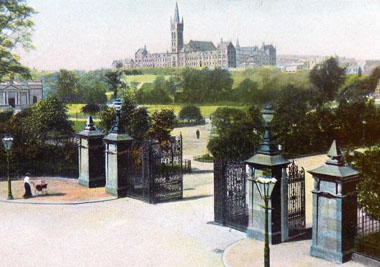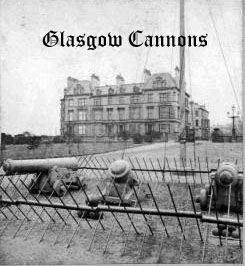
HOME





HOME
|

|

|

|

|
|
P R O F I L E |
||||
|
  CRIMEAN CANNONS - WHERE ARE THEY NOW?
CRIMEAN CANNONS - WHERE ARE THEY NOW?Park Terrace Kelvingrove Park Glasgow Lanarkshire Scotland G12 8QQ A battery of 3 Russian guns captured during the Crimean War of 1854-6, were the first monuments erected in Kelvingrove Park. (see picture right) Kelvingrove Park is a public park located on the River Kelvin in the West End of the city of Glasgow. Erected during the first week of July 1857, these historic monuments disappeared long ago and, until recently, no detailed photograph of the guns was known to exist. The guns were 3 of the many thousands of cannons and mortars captured from the Russians during the Crimean War. Glasgow's guns comprised a trench mortar, which had been captured by HMS Blenheim in Finland, during the first Baltic Campaign of March - June 1854. The other guns were two ship's cannons "of a large size and beautiful finish, mounted upon strong handsome carriages", which were captured at the fall of Sebastopol in 1855. In 1898, the guns' wooden carriages were replaced after the originals had rotted and had become dangerous. Some years later, the guns were moved back from the original position and placed closer to the Park Terrace gates. Their original location was later occupied by the statue of Lord Roberts in 1916, during the First World War. We now move to modern day times and an exciting discovery: The riddle of a military cannon which was found in the garden of a house has finally been solved, with help from members of a historical society. The Milngavie and Bearsden Herald ran a story in February 2017 which appealed for information about the cannon which was in the garden of a family home in Switchback Road, Bearsden. The owner of the historic artefact was keen to find out more about it and how it got there. The following update is based on editorial that was published 31 March 2017. Since February, Marie Davidson, secretary of The Historical Association for Glasgow and the West of Scotland and her husband Richard Binns, association treasurer, who live locally, have been doing research to find out more about the cannon. They believe that it may have come from Kelvingrove Park in Glasgow because two Russian cannons, dated 1857, which were gifted to Glasgow, were placed there as a memorial for the fallen soldiers in the Crimean War. Mrs Davidson said: "The cannons reminded people of the charge of the Light Brigade thanks to a poem by Lord Tennyson. It is said that they came from the siege of Sebastopol. They were moved from the park in 1916 to make room for the famous statue of Lord Robert's and nobody knew what happened to them - yet one of them appears to have come to light in a garden in Bearsden in the 1930s, in an area which was previously part of Garscube Estate. After approaching the military museum in Edinburgh the owner has also discovered that two cannons were melted down in 1926 and the third one disappeared. The cannon shows the Russian Imperial symbol of an double headed eagle and looks very similar in size to the ones that were in Kelvingrove Park." "This is a very exciting find and it is now being considered for conservation due to it's historical significance. We are going to help the owner to seek advice from the Scottish Civic Trust and Historic Scotland for the best way forward now. We would like to thank Gary Nisbet, an expert on Glasgow Sculptures, for all his help in solving this mystery." 
Where are they now? AUCTIONEERS are being asked to look out for a 19th century Russian cannon which vanished from Kelvingrove Park decades ago. Earlier this year, an appeal was launched for information about a cannon which had pride of place in the garden of a family home in Bearsden. Researchers decided it was one of two Russian cannons dating from 1857 which were donated to Glasgow as a memorial for the fallen soldiers of the Crimean War and placed in Kelvingrove Park. However, it has vanished again as the house in Switchback Road has been demolished for new flats to be built. It is understood the cannons were moved from the park in 1916 to make room for a statue of Lord Roberts but what happened to them became a mystery. Some thought they had been melted down for the war effort but one somehow turned up in a garden in Bearsden. The battery of guns captured during the Crimean War of 1854-56 was the first monument in Kelvingrove Park. The city council is now hoping to recover the Bearsden cannon and bring it back to the city. An insider said: 'The assumption has always been the cannons were removed to aid the war effort so nobody has been looking for this one over the last 70 to 80 years. Most people thought they had been melted down. Nobody is suggesting whoever has it now took it from Kelvingrove however there is a pretty strong argument it belongs to the people of Glasgow as part of the Common Good. It is certainly part of the city's history.' Website: Click Here ADDITIONAL INFORMATION  LANDSCAPE City Centre REGION Scotland THE FEATURES PRESENT Crimean Cannon Location, past or present |
||||
|